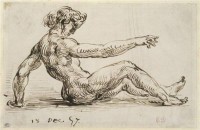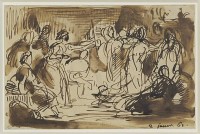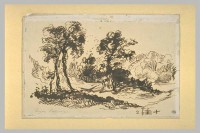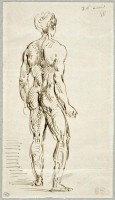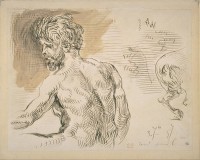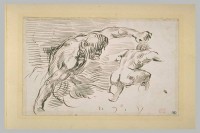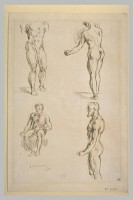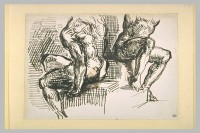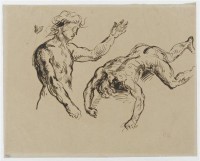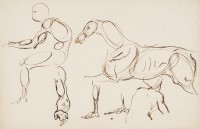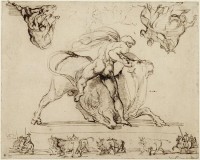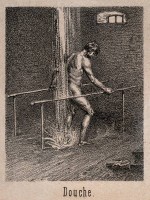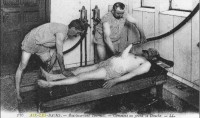The browser will either open the file, download it, or display a dialog.
Throughout his career, Eugène Delacroix (1798–1863) was a prolific draftsman, known for a style of drawing favoring energy, approximation, and ellipsis over careful precision and detail. In the last years of his life, he produced a distinct group of ink drawings in which these features are dramatically prominent. Individual pen strokes are thick and decisive, and spaced widely enough to assert their individuality, thereby calling attention to their gestural energy and rapid, improvisational rhythms.[1] Between 1850 and 1863, Delacroix used this mode of drawing in different subject categories, including figures (fig. 1), compositional studies (fig. 2), landscapes (fig. 3), studies of animals, and copies.[2] As if to indicate self-sufficient completeness, Delacroix added dates to many of them; this contrasts with his customary practice of covering undated sheets with images recording moments in an ongoing train of graphic thought and immediate execution.
Among these categories, a group of figure drawings, most of which are of males and which number at least fifteen, share a similar preoccupation with rounded volumes for muscle masses, coupled with poses and gestures antithetical to physical strength.[3] Most of them are dated between 1856 and 1862, indicating a temporal correspondence to the final phase of an ongoing health crisis that began in the 1840s. Severe and debilitating throat and muscular ailments increasingly plagued the painter from his early forties until his death at age sixty-five in 1863. His effort to cope with his illness included nine trips for therapeutic water treatments. Being a patient within this context of nineteenth-century medical practices entailed his surrender to a variety of physical regimens and corresponding adjustments to his daily life. His health and related preoccupations became increasingly central in life as he aged, just as his attainments, mastery, and mental energy for his work were peaking. Scholarship focused on Delacroix’s late work may note his illness and record periods of time when he was unable to work, but this literature does not explore its significance.[4] A broader view reveals that corresponding with his illness and recuperative strategies, the balance of professional vigor and mental energy on the one hand, and physical decline and fragility on the other, was an important theme in Delacroix’s experience and reflections. This opposition, I argue, provides an appropriate frame of reference for interpreting a new level of meaning for his late ink drawings of the human body.
Muscle Masses, Poses, and Gestures
In these drawings, Delacroix indicates plastic form primarily through ovoid volumes, shaped by widely spaced bracelet hatching (parallel curves to create effects of roundness). The forms are often powerfully volumetric and assertive, emphatically eliciting attention to their massiveness. In some drawings, such as Standing Nude Man (dated April 26, 1858; fig. 4), the individual round forms read as toned muscle, integrated into an athletic body at rest.[5] However, more commonly, the bulky muscle masses create ambiguities and even disturbing effects that contradict healthy physiological structure. An example is Bearded Man from the Waist-Up and Rump of a Horse (dated September 3, 1857; fig. 5), in which the musculature on the torso and back have a heft and scale that is not maintained in the leanness and relative weakness in the man’s left arm and shoulder area or in the limpness of the pose.[6] On the other side of his body, the rounded formation of the elbow area results in a limb that appears locked in place and incapable of movement. The overall pose and facial expression suggest a meekness that is at odds with the powerful corporeal capability indicated by muscular development. Other drawings show similar combinations of ability and disability. In Nude Bearded Man and Nude Man Running (dated November 20, 1857; fig. 6), the bearded man is dramatically muscle-bound, but his pose is hunched over and his head hangs heavily.[7] The two standing muscular figures at the top of Four Studies of Nude Men (dated April 26, 1858; fig. 7) are wobbly and unstable, as if incapable of bearing the weight of the exaggeratedly enlarged muscles of their legs and gluteal muscles.[8] In Two Studies of Seated Nude Men (fig. 8), the muscles on the back are extremely massive, but the ellipses and openness of forms create an air-filled, pneumatic effect, more like swelling than strength.[9]
Similarly, in the Nude Person Seated, Facing Right (dated December 18, 1857; fig. 1), the exaggeratedly volumetric musculature extends to the overall shapes of the upper and lower torso, the latter so rounded as to make the gender ambiguous. In this figure, the bulging roundness is coupled with a pose of physical fragility, creating in the muscles a disturbing suggestion of hypertrophy, that is, an abnormal enlargement, rather than strength. Though extremely muscular like a bodybuilder, the power seems ineffectual;[10] it is difficult to imagine this person having the force and equilibrium to rise up from the ground. In Two Studies of Nude Men, One from the Waist-Up and One Falling to the Ground (fig. 9), hypertrophic muscular development is useless for the strongman, who collapses without any effort to break the fall.[11] Among all these drawings, no overt disease or injury is apparent; yet, to varying degrees, the combination of the surplus of brawn with a deficiency of vitality evokes a sense of unsettling abnormality. By virtue of these expressive effects, the figures function as metaphors of a conflicted state, combining powerful vitality and helplessness.[12]
Contexts and Levels of Meaning
Familiar art-historical contexts provide interpretive frameworks for several different levels of meaning for these drawings. First, they are meaningful as antitheses to academic life drawings (académies), which normally resemble well-lit classical sculpture, with firm contours reinforced by gently blended modeling. The académie, albeit idealized, is a convincing simulacrum of a perceived human being, with legible and well-balanced pose and gesture.[13] Delacroix’s drawings resemble académies in their focus on the figure with little indication of setting. However, the figures themselves subvert all the familiar elements of the genre: interior modeling dominates with little indication of lighting, contours are broken and discontinuous, and gestures and actions are difficult to interpret. They look more imagined than seen.[14] Indeed, judging by their inscriptions and corresponding biographical information, in all likelihood there were no live models for these drawings.[15] Throughout his career, Delacroix rejected the visual norms, aesthetic assumptions, and artistic lineage of academic classicism. In the case of these late figure drawings—as well as in his contemporaneous endeavor to explore life drawing using photographic models—Delacroix rejected academic norms by subverting the académie.[16]
A second level of meaning concerns the technique of using ovoid shapes, which raises the possibility that these drawings relate to Delacroix’s “system of rounds.” The system of rounds, also called “drawing by the middles or cores,” was an idiosyncratic part of his theory of drawing.[17] According to several contemporary biographers, Delacroix theorized the system of rounds with reference to analyzing classical sculpture. Although the conventional view was that the external contour was key in classical sculpture, Delacroix asserted that, to the contrary, interior volumes were preeminent. As the story goes, he illustrated the concept with a drawing: he drew a few general oblong shapes and then connected them with contours, to diagram the notion that contours were consequential, rather than primary. Studies of a Horse and Human Figures (1830s; fig. 10) is one of a few examples that illustrate the concept explicitly.[18] A more subtle application occurs in a series of lithographs of Greek coins that Delacroix produced in 1825. They picture what a classical relief looks like when the contours have worn away and only the interior modeling remains. However, in the coin lithographs the constituent planes are flat and irregular in shape—not actually ovals or “rounds.”[19] In the ink figure drawings, on the other hand, volumetric oblongs are clearly present, with the rounds corresponding to enlarged muscle masses. Their preeminent role in the overall form of the figures evokes the concept of drawing by rounds, but with a distinctive expressive effect of copious massiveness and palpability.[20] The rounded forms are bulbous, but they are not hard and sculptural. The openness of the forms softens them, such that they suggest a fleshy texture and thereby powerfully evoke physicality and somatic sensation.
A third level of meaning concerns affinities with certain figures of Delacroix’s deceased contemporary, Théodore Géricault (1791–1824). In drawings as well as paintings, Géricault routinely created male figures with exaggeratedly muscular physiques, thereby embracing the legacy of artists like Michelangelo and Peter Paul Rubens.[21] Like the figures of his artistic predecessors, Géricault’s men are typically engaged in feats of strength and aggressive actions that require power and, therefore, justify their Herculean builds.[22] The figure in Nude Man Tackling a Bull; Herd of Cattle and Roman Cowherds (1817; fig. 11) typifies Géricault’s strongmen, who, in contrast to those of Delacroix, exert their strength to oppose powerful forces.[23] Contemporaries of Géricault may have disapproved of his exaggerations as excessive and mannerist, but nonetheless they clearly understood them to be expressions of libidinal masculine power.[24] Norman Bryson, in a study of Géricault and constructions of nineteenth-century male identity, considers a subgroup of Géricault’s brawny male figures whose qualities compare in interesting ways with those of Delacroix’s figures. Géricault’s figures are able-bodied soldiers who are wounded or otherwise excluded from battle. Bryson characterizes figures like those in A Wounded Cuirassier Leaving Battle (1814; Louvre, Paris) or Seated Hussar Trumpeter (1813–14; Kunsthistorisches Museum, Vienna) as strong men who “don’t live up to their own signs of strength.”[25] Noting that these figures express conditions of rest “bordering on the convalescent,” Bryson argues that the combination of masculine bravura and inaction were meaningful within the context of military and political conditions at the time of the defeat of Napoleon’s army and related constructions of masculinity.[26] The French body politic, and gender assumptions therein, figured prominently in Géricault’s concerns. Géricault’s soldiers, unable to fight, parallel Delacroix’s fragile strongmen, but the latter are meaningful within a different context. When Delacroix created the ink figure drawings, his daily experience increasingly foregrounded his physical ailments and the resulting weaknesses. Pursuing medical treatment at water therapy spas brought him into environments where he was preoccupied with his own health and where he also was surrounded by other patients in similarly weakened states. His health, and the activities he undertook because of his health, framed his personal experience during his final decade. The artist’s medical condition and resulting activities, outlined below, provide a frame through which the fragility and vulnerability of his late figure drawings take on new meaning.
Illness and Medical Itinerary, 1840s to 1863
In his early forties, Delacroix experienced the initial onset of two medical conditions that would plague him for the rest of his life. The first to occur was atony, a condition of abnormal muscle relaxation and loss of strength. Delacroix’s earliest mention of this ailment was in the fall of 1841, when he was in Trouville, a coastal town in the Normandy region of France, attempting to remedy it by undergoing his first treatment of thalassotherapy, the restorative use of sea climate and baths in seawater.[27] He treated the persistence of atony in later years with four therapeutic trips to Dieppe, also on the coast of Normandy (a week in 1852, five weeks in 1854, twelve days in 1855, and nine days in 1860).[28]
Not long after his treatment at Trouville, in the winter of 1841 he suffered his initial bout of a second recurring ailment, severe problems with his throat and larynx, accompanied by fever and debilitating weakness.[29] Initially he recovered, but he had a relapse in the spring of 1842. For the next two years, the condition persisted, prompting him in 1845 to undertake hydrotherapy, the medicinal use of bathing in and drinking thermal and mineral waters.[30] Delacroix would undergo four different hydrotherapy regimens, each under the care of a physician. His first hydrotherapy treatment was at the thermal spa at Eaux-Bonnes in the French Pyrenees.[31] After a temporary improvement, the illness and fever returned, making him easily exhausted and unable to work. Weakness of the voice preceded the onset of illness, prompting him to begin the practice of self-imposed silence.[32] In 1850, he underwent his second hydrotherapy regime at Ems, in the German Rhineland.[33]
In the winter of 1856, he had a severe relapse of the throat ailment, and his symptoms persisted for six months. During this relapse, he was unable to work or socialize, and talking for even brief periods caused setbacks.[34] In the early summer of 1857, he acknowledged the cumulative effect of the prolonged illness that was gradually draining him of his physical strength (“m’ôte graduellement mes forces”).[35] Following this relapse, he underwent two three-week treatments at the spa at Plombières, in the Vosges in eastern France (1857 and 1858).[36] Between 1859 and his death in 1863, Delacroix experienced a pattern of falling ill, often suddenly, with cold-like symptoms, laryngitis, and weakness.[37] In the spring of 1863, he had another severe relapse, which would be his last.[38] When the symptoms subsided, he was severely debilitated. He died in August of that year.
Delacroix coped with his illness on two different fronts: one, by undergoing thalassotherapy and hydrotherapy at the various destinations as outlined above, and the other by devising and deploying in daily life a number of physical regimens.
Spa Therapies and Daily Regimens
Unlike modern medicine, which focuses on identifying and eliminating disease, nineteenth-century medical practice treated ailments by improving a patient’s constitution—that is, the entire body. The constitution was seen as vulnerable to weakening forces that could unbalance it: unsuitable types or amounts of food, too much work, and the nasty climates and the bad air of cities. If the constitution was weakened, the body became unable to resist disease.[39] Nineteenth-century water-treatment spas sought to restore the constitution and cure chronic ailments through various combinations of drinking local waters and/or bathing in them, combined with regimens of diet and mild exercise. Though claims were made about the medicinal properties of the waters, they were not medicine in the modern, chemical sense. However, they were espoused to have powerful vital properties that could effectively intervene to restore a healthy constitution.[40] A typical water treatment might last several weeks.[41] Establishing a strict regimen of diet and lifestyle while taking the waters, and maintaining it after, was key to treatment. Ironically, a kind of corporeal disempowerment is inherent in the treatment itself, which requires surrendering to the regimentation.
Nineteenth-century images of therapeutic practices corroborate the disempowerment of the patient experience.[42] One example is an illustration of a patient submitting to a cold shower (fig. 12).[43] A second is a photograph of a patient getting a shower massage on a postcard for Aix-les-Bains (fig. 13).[44] Both images indicate that passivity and helplessness are inherent aspects of the spa treatment experience.[45] Due to Delacroix’s numerous spa visits, noted above, this spa therapy ethos of the body became part of his normal experience.
In addition to his water treatments, his regimens of diet, exercise and, in Delacroix’s case, not talking, became a focus of his daily life and a preoccupation of his thoughts. His routines entailed restricting eating to one meal a day,[46] severely limiting social contact because it required talking,[47] keeping in constant motion during the day, and going to bed early.[48] His therapeutic “mutisme,” which resulted in social isolation, was perhaps the most difficult regimen.[49] References to his regimens, and his successes and failures in following them, were steady refrains in his reflections, especially after the lengthy illness of early 1857—the period corresponding to the production of the ink drawings.[50] He disliked surrendering his pleasures, and he found following the regimens awkward and alienating. He referred to his daily routine as “a strange way of life” (l’étrange vie).[51] In the following passage, written in 1861, he counted the cost of his surrender:
The only way I can keep up this life is to go to bed early and do nothing whatsoever outside my work, and I am sustained in my resolution to give up every pleasure, and most of all that of seeing the people I love, only by the hope of carrying the work through to completion. I think it will kill me.[52]
As Delacroix aged, his particular pattern of ailments and healthcare regimens shaped a distinctive awareness of his physical condition. This is abundantly clear in his reflections and, I argue, when considered in the context of opposing reflections on his increasing mental strength, which are meaningfully applicable to interpreting the figure drawings.
Work and Mental Strength
Delacroix made his health choices with one thing only in mind: his work, the part of life where he felt strong. Work was the one pleasure he refused to deny himself. His reflections make it clear that the purpose of all his health strategies was not just to feel better. Rather, the purpose was to mitigate his physical decline and attain the physical vigor needed for the series of exceptional artistic opportunities that began to arise just as coping with illness was becoming a significant part of his everyday life.
The onset of illness in the 1840s coincided with his first major mural commissions (ceiling paintings of the libraries of the Palais Bourbon and Palais Luxembourg), which, because of their scale and location, entailed significant physical demands. In the 1850s, as his weakness and fatigue became more regular, the demands of work increased. In that decade, he was awarded additional mural commissions that were glorious, but that again presented huge physical challenges: the ceiling of the Galerie d’Apollon at the new Louvre museum, the Salon de la Paix at the Hôtel de Ville, and the Chapelle des Saints-Anges in the Church of Saint-Sulpice. Throughout this period, he also maintained a high level of easel-painting productivity as he prepared for a retrospective in the 1855 Éxposition Universelle and the Salon of 1859, his last.[53] As is evident in his letters and diary, he recognized that he needed to work at a level of intensity that he had not anticipated. As early as 1844, he noted with dismay that he had more work, and more challenging work, than he had had when he was in his twenties.[54] In 1852, he admitted that for two years he had been overworking.[55] He became increasingly aware of the imbalance between the escalating energy needed for his work and his progressive physical decline, and regularly counted the cost of one to the other when making healthcare decisions.[56] For instance, in a letter to his doctor in 1850, he stated that his motivation for going for treatment at the spa at Ems was to build a reserve of energy for the task of decorating the ceiling of the Galerie d’Apollon.[57]
While for many nineteenth-century artists and intellectuals it was common to suffer from neurasthenia, Delacroix’s complaint was physical fatigue and fragility, not mind weariness.[58] In fact, in his later years he frequently noted in his diary that his mental strength and creative force were increasing.[59] He was struck by the recognition that the diminution of strength in the body and the senses, whether by aging alone or with illness, could result in an increase to the strength of the mind. Though he was convinced this was true, he found it something of a contradiction. He wrote,
This singular incongruity between the power of the mind that age brings, and the weakening of the body which is also its consequence, always strikes me and seems to me a contradiction in the laws of nature.[60]
At no time did Delacroix feel the extraordinary robustness of his mental powers as he did while working. He expressed extremely positive feelings about his work in his diary and letters from the 1850s to the end of his life. He felt himself to be working at the highest level of artistic ability and believed that the joy he experienced in work was an exceptional happiness.[61] Though contemporary admirers celebrated intangibles like imagination and genius, the love of work Delacroix experienced and wrote about emphasized his immersion in his own practice.[62] In his writings are many enthusiastic declarations that give evidence of the powerful emotions and buoyance he experienced while working. For example, in December 1853 he wrote, “I get myself up at dawn and, even at this time of year, through the cold and the snow, I run to my work with ardor and pleasure.”[63] While working he experienced a pleasing vigor absent in other activities, which unfortunately made him overextend himself and increased the resulting exhaustion.[64] Nonetheless, the joy and excitement he experienced from his artistic practice was exceptional; it endured, and became ever more important, as he restricted all other activities and regimented his life. As other satisfactions evaporated, he regarded working as the only activity he enjoyed, the only pleasure “unmixed with the bitterness of regret.”[65]
Framework for Figure Drawings
During the years in which he produced the ink figure drawings, Delacroix’s health and strategies about healthcare factored into a particularly acute and persistent awareness of his body and its diminution of strength and energy. At the same time, he experienced extraordinary creative power and an intensification of mental strength. The two conflicting and oscillating aspects of his experience parallel the opposition of strength and weakness prominent in the figure drawings. Delacroix used a rich variety of artistic components to achieve within a single figure this combination of antithetical qualities. To focus attention on the body in isolation, he adapted the académie life-drawing form (fig. 1). To highlight muscular strength while also making the physiology appear fleshy and limp, he applied the system of rounds using loosely structured hatching to dilate the masses (fig. 5). Disequilibrium in poses and atonic, ineffectual gestures further suggest debility and frailty (fig. 9). He responded to the legacy of predecessors like Rubens or Géricault, but instead of strongmen with bulging muscles engaged athletically, Delacroix’s figures express an unsettling opposition of strength and fragility. Considering these drawings in the context of the artist’s declining health permits us to recognize that they function as metaphors of the conflict of power and helplessness that, in his final decade, he experienced in his own body and mind.
I am grateful to Prof. Michèle Hannoosh for her helpful suggestions on the draft of this essay. All translations are by the author unless otherwise indicated.
[1] Maurice Sérullaz states that the ink drawings have a privileged status within the third and final period of Delacroix’s drawing production (1850–63). Sérullaz identifies the distinctive feature of their style as an explosiveness and “une sûreté autoritaire des traits qui fait elle-même symbole” (an authoritative surety of the strokes that makes them emblematic in and of themselves). Maurice Sérullaz, ed., Inventaire général des dessins, École française. Dessins d’Eugène Delacroix (1798–1863), 2 vols. (Paris: Editions de la Réunion des Musées Nationaux, 1984), 1:19. The catalogue accompanying the 1998–99 exhibition of late work included a section on “Religious Drawings from the Winter of 1862,” a group of technically comparable compositional drawings that includes figure 2, The Denial of Saint Peter. Arlette Sérullaz, Vincent Pomarède, Joseph J. Rishel et al., Delacroix: The Late Work, exh. cat. (Philadelphia: Philadelphia Museum of Art, 1999), 329–39. For detailed information about Delacroix’s employment of his preferred drawing materials, see Marjorie Shelley, “Line and Color: The Drawing Practices of Delacroix,” in Delacroix Drawings: The Karen B. Cohen Collection, ed. Ashley E. Dunn, exh. cat. (New York: Metropolitan Museum of Art, 2018).
[2] An example from the animal category is Eugène Delacroix, Study of a Feline, Called the Puma, dated in ink “10. Xb. 52,” pen and brown ink, 4 17/32 x 5 15/64 in., RF 9683, Louvre, Paris; M. Sérullaz, Inventaire, 1:395, no. 1089. An example of a copy is Two Studies of a Nude Man (after bronze oil lamp by Andrea Ricci), 1860, pen and brown ink, 9 1/4 x 14 1/16 in., D2401, Musée des Beaux-Arts et d’Archéologie de Besançon, Besançon, France; A. Sérullaz, Late Work, 366, no. 78.
[3] In addition to the seven figure drawings illustrated in this study, the following eight by Eugène Delacroix, not illustrated, comprise the group of fifteen: Semi-Nude Man, from Behind, and Lion Lying Down, dated in ink “5 nov. 56,” pen, brown ink, and brown wash, 9 11/64 x 14 3/32 in., RF 9483, Louvre, Paris; M. Sérullaz, Inventaire, 1:328, no. 829. Three Persons, Partially Nude, with Woman Holding a Flower, dated in ink “Strg. 27 août 59,” pen and brown ink, 9 1/16 x 11 29/64 in., RF 9526, Louvre, Paris; M. Sérullaz, Inventaire, 1:330, no. 838. Semi-Nude Man, Seated on Ground, dated in ink “9 mars 60,” pen and brown ink, 5 13/64 x 8 5/64 in., RF 9533, Louvre, Paris; M. Sérullaz, Inventaire, 1:331, no. 839. Three Studies of Nudes, One Seated, dated in ink “11 nov. 62 Champ(rosay),” pen and brown ink, 8 5/64 x 5 15/64 in., RF 9549, Louvre, Paris; M. Sérullaz, Inventaire, 1:331, no. 841. Sheet of Studies of Three Semi-Nude Men, One Seated, ca. 1849–60, pen and brown ink, 5 5/16 x 8 5/64 in., RF 9593, Louvre, Paris; M. Sérullaz, Inventaire, 1:338, no. 880. Two Nude Men, Half-Figures, ca. 1857–63, pen and brown ink, 7 3/64 x 8 13/16 in., RF 22942, Louvre, Paris M. Sérullaz, Inventaire, 1:339, no. 884. Sheet of Studies with Semi-Nude Man and Feline, dated in ink “9 août 60 Champrosay,” pen and brown ink, 12 23/64 x 8 25/64 in., RF 9733, Louvre, Paris; M. Sérullaz, Inventaire, 1:331, no. 840. Reclining Lion and Semi-Nude Man, from the Back, ca. 1857, pen and brown ink, 8 3/8 x 12 1/16 in., F II 83, Museum Boymans-van Beuningen, Rotterdam; A. Sérullaz, Late Work, 365, no. 73. The following four are related but do not clearly exhibit the exaggerated musculature: Nude Man, Stalking, ca. 1853, pen and brown ink, 6 7/32 x 7 63/64 in., RF 9462, Louvre, Paris; M. Sérullaz, Inventaire, 1:338, no. 881. Nude Woman Reclining, Holding a Mirror, dated in ink “7. 7bre 57 [or 59?],” pen and brown ink, 5 5/32 x 8 5/64 in., RF 9629, Louvre, Paris; M. Sérullaz, Inventaire, 1:328, no. 832. Nude Women Bathing, 1854, pen and brown ink over graphite sketch, 9 15/16 x 15 7/16 in., No. 2031B, Fitzwilliam Museum, Cambridge, UK; A. Sérullaz, Late Work, 365, no. 71. Seated Nude Woman, from Back, and Antique Soldier, dated in ink “3. 7bre 57,” pen and brown ink, 5 13/64 x 8 5/64 in., RF 9592, Louvre, Paris; M. Sérullaz, Inventaire, 1:328, no. 831. In all likelihood, other works dispersed in various public and private collections might be added to this group, for example, in Alfred Robaut, L’Œuvre complet de Eugène Delacroix: Peintures, dessins, gravures, lithographies (Paris: Charavay frères, 1885), 353 (current whereabouts unknown).
[4] It is barely noted, for example in Dominique de Font-Réaulx, “Delacroix and the Exposition Universelle of 1855,” in Delacroix, eds. Sébastien Allard and Côme Fabre, exh. cat. (New York: Metropolitan Museum of Art, 2018), 257, fn16. The 1998–99 exhibition of Delacroix’s painting and drawings from 1850 to 1863 (A. Sérullaz, Late Work) used a thematic approach, investigating works within the context of familiar categories of subject matter. That sorting did not use a category, such as bathers or nudes, for which Delacroix’s health and healthcare experiences might be applicable. Sagne’s study of the exploration of photography Delacroix undertook in 1854 in Dieppe makes no reference to Dieppe as a health-related destination. See Jean Sagne, Delacroix et la photographie (Paris: Herscher, 1982). Polistena’s study includes material on somatic expression, related to Delacroix’s innovations in representing the suffering Christ, but makes no reference to Delacroix’s own physical suffering. Joyce Carol Polistena, The Religious Paintings of Eugène Delacroix (1798–1863): The Initiator of the Style of Modern Religious Art (Lewiston, NY: Edwin Mellen Press, 2008), 158–80.
[5] Eugène Delacroix, Standing Nude Man, Seen from Back, dated in ink “26 avril 58,” pen and brown ink, 7 31/64 x 4 11/64 in., RF 32265, Louvre, Paris; M. Sérullaz, Inventaire, 1:330, no. 835.
[6] Eugène Delacroix, Bearded Man from the Waist-Up and Rump of a Horse, dated in ink “3, 7bre 57,” and annotated “revt de Pl.res,” pen and brown ink, 8 15/64 x 10 43/64 in., RF 9511, Louvre, Paris; M. Sérullaz, Inventaire, 1:328, no. 830.
[7] Eugène Delacroix, Nude Bearded Man, and Nude Man Running from Back, towards the Right, dated in ink “20. 9bre 57,” pen and brown ink, 5 5/64 x 8 5/64 in., RF 9510, Louvre, Paris; M. Sérullaz, Inventaire, 1:328, no. 833.
[8] Eugène Delacroix, Four Studies of Nude Men, dated in ink “26 avril 58,” pen and brown ink, 12 13/32 x 8 17/64 in., RF 9525, Louvre, Paris; M. Sérullaz, Inventaire, 1:330, no. 836.
[9] Eugène Delacroix, Two Studies of Seated Nude Men, ca. 1857–63, pen and brown ink, 6 17/64 x 9 1/16 in., RF 9591, Louvre, Paris; M. Sérullaz, Inventaire, 1:339, no. 883.
[10] Nineteenth-century bodybuilding is addressed below in note 45.
[11] Eugène Delacroix, Two Studies of Seated Nude Men, One from the Waist-Up and the Other Falling to the Ground, ca. 1857–63, pen and brown ink, 7 1/8 x 9 1/64 in., RF 32264, Louvre, Paris; M. Sérullaz, Inventaire, 1:338, no. 882.
[12] Delacroix’s aesthetic of l’intérêt (interest) applies to this combination. Hannoosh identifies the comingling in a single image of antithetical viewpoints as a key component of Delacroix’s aesthetic concept of l’intérêt. She defines l’intérêt as the concentration of idea and effect so as to produce thought, rather than to state a single message. Hannoosh traces the manifestation of this aesthetic especially among Delacroix’s major mural commissions. Michèle Hannoosh, Painting and the Journal of Eugène Delacroix (Princeton, NJ: Princeton University Press, 1995), 11–17 passim.
[13] Albert Boime, The Academy and French Painting in the Nineteenth Century (London: Phaidon, 1971), 23–32; Dorothy Johnson, Jacques-Louis David, Art in Metamorphosis (Princeton, NJ: Princeton University Press, 1993), 18–19; John Elderfield, The Language of the Body: Drawings by Pierre-Paul Prud’hon (New York: Abrams, 1996), 57–66.
[14] Dunn references an “association between ink and invention” in Delacroix’s drawings. Ashley E. Dunn, “Delacroix as a Draftsman: Through the Lens of the Karen B. Cohen Collection,” in Delacroix Drawings Cohen Collection, ed. Ashley E. Dunn, exh. cat. (New York: Metropolitan Museum of Art, 2018), 45, fn140.
[15] On several drawings, Delacroix noted that they were produced while in Champrosay or in Strasbourg; for a reference to Delacroix sketching while socializing with his relatives in Strasbourg, see A. Sérullaz, Late Work, 192. Two drawings dated September 3, 1857, were not likely to have been created in the studio because on that day Delacroix noted in his journal that he had just returned to Paris from treatment at Plombières and was awaiting the visit of his doctor. Eugène Delacroix, Journal, 2 vols., ed. Michèle Hannoosh (Paris: José Corti, 2009), 1:1173. Other drawings bear dates corresponding to periods of illness outlined below (in April 1858 and in March 1860, for example), during which time he would not interact with anyone, much less models in the studio.
[16] His production of drawings of figures photographed by Eugène Durieu in the 1850s is another example of his return to this basic drawing exercise. Delacroix collaborated with Durieu on staging photographs of nude models. During the photography sessions, he made life drawings of the models, and later he copied Durieu’s photographs, producing drawings in several different drawing styles. See Eugène Delacroix, Christophe Leribault, and Sylvie Aubenas, Delacroix et la photographie (Paris: Musée du Louvre Éditions, 2008). Many of the drawings copied from photographs imitate distinctive features of the models, such as their grainy textures, indistinct forms, and subtle atmospheric shadow paths, and as such contrast dramatically with the style of the ink académies. See Joyce Bernstein Howell, “Eugène Delacroix’s Review of Le Dessin sans maître and the Modernized Discourse of Drawing,” Word & Image 21, no. 3 (2005): 235–36.
[17] For the various terms and their sources, see Joyce Bernstein Howell, “Delacroix’s Lithographs of Antique Coins,” Gazette des Beaux-Arts 124 (1994): 16, 22. See also Lorenz Eitner, “Sheet of Figure Studies by Delacroix,” Stanford University Art Gallery Bulletin 6–7 (1976–77): 6.
[18] A similarly explicit example is a sheet of figure studies from inside the bellows pocket of one of the albums Delacroix produced on his trip to North Africa and Spain in 1832. Eugène Delacroix, Two Nude Figures, 1832, pen and brown ink with lead pencil, 8 3/16 x 5 5/16 in., RF 1712 bis, Louvre, Paris; M. Sérullaz, Inventaire, 2:385, no. 1756.
[19] For a discussion of expressive effects of medium and surface in the coin lithographs, see Howell, “Lithographs,” 20.
[20] The effect recalls Delacroix’s admiration of Rubens’s “prodigious relief”; see his entry for October 21, 1860, in Delacroix, Journal, 2:1368. For the connection between this reflection on Rubens and the figure drawing produced contemporaneously in Champrosay (Sheet of Studies with Semi-Nude Man and Feline, cited in note 6 above), see A. Sérullaz, Late Work, 195. Also recognizing a connection with Rubens’s exaggerated plasticity, Badt describes how Delacroix used line to indicate mass. Instead of using line to invite the eye to follow its direction, Delacroix related lines to one another “in such a way that the eye has to interpret them as the bounds of a corporeal, a plastic form situated within them.” Kurt Badt, Eugène Delacroix Drawings (Oxford, UK: Bruno Cassirer, 1946), 48.
[21] Martial Guédron, La Plaie et le couteau: la sensibilité anatomique de Théodore Géricault (1791–1824) (Paris: Kimé, 1997), 72–74; and Dunn, “Delacroix as a Draftsman,” 19–21.
[22] In his own early drawings after Rubens, as well as in later examples relating to the Hercules lunettes for the Hotel de Ville, Delacroix’s graphic work contains examples of exaggerated male musculature in which, even though the exaggerations are justified by the narrative situation, the bodies are nonetheless in states of extreme suffering, and as such have a thematic connection to the ink figure drawings which are the focus of my study. For the copies after Rubens, see Dunn, “Delacroix as a Draftsman,” 19–22, plates 12–14. For an example from the labors of Hercules, see the lithograph Hercules and Anteus (1852), Metropolitan Museum of Art, The Met Collection, accessed June 19, 2019, https://www.metmuseum.org/art/collection/search/337354.
[23] Théodore Géricault, Nude Man Tackling a Bull; Herd of Cattle and Roman Cowherds, 1817, pen and brown ink, 9 29/64 x 11 13/16 in., Musée du Louve, Paris.
[24] Guédron, La Plaie et le couteau, 33–62; Guédron also investigates connections with contemporary Michelangelo criticism (72–74).
[25] Norman Bryson, “Géricault and Masculinity,” in Visual Culture: Images and Interpretations, ed. Norman Bryson, Michael Ann Holly, and Keith Moxey (Hanover, NH: Wesleyan University Press, 1994), 239–40. For illustrations, see 241.
[26] Bryson, “Géricault and Masculinity,” 241. Studies investigating the intersection of physical health and gender constructions of masculinity in nineteenth-century Western culture include Michael Anton Budd, The Sculpture Machine: Physical Culture and Body Politics in the Age of Empire (New York: NYU Press, 1997); and Sarah Burns, Inventing the Modern Artist: Art & Culture in Guilded Age America (New Haven, CT: Yale University Press, 1996), 79–158.
[27] Letter to George Sand, September 11, 1841, in Eugène Delacroix, Correspondance générale d’Eugène Delacroix, 5 vols., ed. André Joubin (Paris: Librairie Plon, 1936–38), 2:84–86.
[28] His journal documents that he returned to Dieppe for baths and recuperation three more times. See Delacroix, Journal, 1:810–16 (August 19–September 26, 1854); 1:959–66 (October 4–13, 1855); and 2:1354–1359 (July 18–25, 1860).
[29] Letter to Sand, April 10, 1842, Delacroix, Correspondance, 2:97. Though impossible to diagnose, in all likelihood the root of Delacroix’s most serious health problems were complications from a bacterial infection. As an aside, one cannot help but wonder if he originally contracted the infection at his first spa visit in Trouville in the fall of 1841, where he literally was immersed in an environment full of contagion.
[30] Letter to Sand, November 21, 1844, Delacroix, Correspondance, 2:201–3.
[31] Delacroix was at Eaux-Bonnes in late July and early August 1845; see letter to Frédéric Villot, July 24, 1845, Delacroix, Correspondance, 2:223–24. The spa at Eaux-Bonnes was primarily a medical facility (rather than for leisure), specializing in pulmonary and throat ailments. See Jérôme Penez, Histoire du thermalisme en France au XIXe siècle. Eau, médecine, et loisirs (Paris: Economica, 2005), 127–95. Penez’s study includes specific information about the spa at Plombières, where Delacroix also went for treatment.
[32] In 1847, he had a fever that lasted two months. See letter to Sand, May 12, 1847, Delacroix, Correspondance, 2:314–16. In an 1850 letter, he explains that since weakness of the voice was the tipping point, he did not speak to anyone. See letter to Joséphine de Forget, April 30, 1850, Delacroix, Correspondance, 3:13–14.
[33] His trip to the spa at Ems occurred in August 1850, and he included in his itinerary visits to Brussels, Antwerp, Malines, and Cologne. See Delacroix, Journal, 1:517–45.
[34] “Lettre à Pierre-Antone Berryer, 08 janvier 1857,” Musée Eugène Delacroix, Paris, L’édition électronique de la Correspondance de Delacroix, published 2010, accessed October 7, 2018, http://www.correspondance-delacroix.fr/correspondances/bdd/correspondance/406. In January 1857, much of Delacroix’s correspondence related to his election to the Institut included references to his illness and his inability to go out. See, for example, letter to artist Paul Huet, January 13, 1857, Delacroix, Correspondance, 3:364, and letter to the painter Jeanne-Mathilde Herbelin, January 2, 1857, Delacroix, Correspondance, 3:355. For the persistence of illness into the following summer, see, for example, letter to the painter Adrien Dauzats, June 29, 1857, Delacroix, Correspondance, 3:395; and Delacroix, Journal, 1:1155 (May 24, 1857), and 1:1157 (June 5, 1857).
[35] Delacroix, Journal, 1:1157 (June 24, 1857).
[36] A. Sérullaz’s chronology notes the travel to the spas at Eaux-Bonnes, Ems, and Plombières, but omits the 1841 therapeutic trip to Trouville, and lists the trips to Dieppe without noting thalassotherapy there. In addition to his travel to visit spas, health concerns were instrumental in his 1857 decision to move his studio closer to Saint-Sulpice, and his purchase of the suburban retreat at Champrosay in 1858. Arlette Sérullaz, “Chronology,” in A. Sérullaz, Late Work, 18–24.
[37] In the spring of 1860 he was ill for two months (see letter to George Sand, March 9, 1860, Delacroix, Correspondance, 4:149–50). See also the letter to his cousin Guillaume Auguste Lamey, January 7, 1860, Delacroix, Correspondance, 4:147–49; and letter to Berryer, April 13, 1862, Delacroix, Correspondance, 4:311–12.
[38] Letter to Berryer, July 13, 1863, cited in A. Serullaz, Late Work, 24.
[39] Penez, Histoire du thermalisme, 116–66. Spa treatments contrasted with remedies such as bloodletting and administering substances like opium, quinine, and mercury. See Jon Sterngass, First Resorts: Pursuing Pleasure at Saratoga Springs, Newport, and Coney Island (Baltimore, MD: Johns Hopkins University Press, 2001), 8–9.
[40] Penez provides detailed information on the issue of the chemical properties of waters and questions of their effectiveness. Penez, Histoire du thermalisme, 131–37. Donegan gives an overview of the origins of the medicinal use of water before the nineteenth century and in the work of the Austrian Vincenz Priessnitz. Jane B. Donegan, “Hydropathic Highway to Health”: Women and Water-Cure in Antebellum America (New York: No. 17 Praeger Pub Text, 1986), 3–7. Corbin’s explanation of beliefs about the power of seawater to restore “tonicity in human fibre” is especially relevant to Delacroix’s frequent travel to the sea in Normandy. Alain Corbin, The Lure of the Sea: The Discovery of the Seaside in the Western World 1750–1840, trans. Jocelyn Phelps (Berkeley: University of California Press, 1994), 62–63. Browne’s study describes evocative details of specific water treatments, like wet-sheet packing and cold showers. Janet Browne, “Spas and Sensibilities: Darwin at Malvern,” in The Medical History of Waters and Spas, ed. Roy Porter (London: Medical History, 1990), 107–9.
[41] Stays at nineteenth-century therapeutic spas also played a non-medical role in identity formation of the middle (bourgeois) class. Traditional relations and social mores familiar in everyday society and social spaces did not apply in spas. They functioned as liminal spaces for identity construction. For studies of this issue in France and the United States, respectively, see Douglas Peter Mackaman, Leisure Settings: Bourgeois Culture, Medicine, and the Spa in Modern France (Chicago: University of Chicago Press, 1998), 85–141; and Sterngass, First Resorts. Delacroix expressed both distaste for regulated society at such places and enjoyment of the distractions. See, for example, letter to Charles Soulier, written in Ems, July 15, 1850, Delacroix, Correspondance, 3:29–30; and letter to Mme. de Forget, written in Plombières, July 23, 1858, Delacroix, Correspondance, 4:38–39.
[42] For a discussion of Foucault’s analytic model of the body and the invention of the cultural construction of the “patient” and corresponding “regulatory” models of power, see David Armstrong, “Bodies of Knowledge/Knowledge of Bodies,” in Reassessing Foucault: Power, Medicine, and the Body, eds. Colin Jones and Ray Porter (London: Routledge, 1994), 17–27.
[43] The image, from illustrations of various water cure treatments used by Vincent Priessnitz at his establishment in Gräfenberg, Austria, is reproduced in Browne, “Spas and Sensibilities,” 108, plate 14. Cold showers and other techniques involving the external application of water (as opposed to imbibing mineral water) were thought to have particular therapeutic effects. For J. M. Gully’s technique, to which the image refers, see Browne, “Spas and Sensibilities,” 107.
[44] Image reproduced in Mackaman, Leisure Settings, 114. Mackaman’s book also includes many caricatures of patient defenselessness.
[45] The alter ego of these images, photographs of early bodybuilder Eugen Sandow, irresistibly comes to mind, because the patient and the strongman are two sides of the same coin of a regimented ethos of the body. Studies of bodybuilding and other manifestations of physical culture in the late nineteenth century include David L. Chapman, Sandow the Magnificent: Eugen Sandow and the Beginnings of Bodybuilding (Chicago: University of Illinois Press, 1994); John F. Kasson, Houdini, Tarzan, and the Perfect Man: The White Male Body and the Challenge of Modernity in America (New York: Macmillan, 2001), and Budd, Sculpture Machine.
[46] Letter to Mme. de Forget, May 11, 1853, in which he wrote that he found this part of his regimen humiliating. Delacroix, Correspondance, 3:155–56; and see also letter to Lamey, October 2, 1860, Delacroix, Correspondance, 4:200–202.
[47] See letter to friend and collector Adolphe Moreau, July 8, 1857, Delacroix, Correspondance, 3:397, letter to Lamey, July 28, 1857, Delacroix, Correspondance, 3:400, and letter Berryer, January 8, 1857; “Lettre à Pierre-Antone Berryer, 08 janvier 1857,” L’Édition électronique de la Correspondance, accessed October 7, 2018, http://www.correspondance-delacroix.fr/correspondances/bdd/correspondance/406. Earlier references include a letter to assistant Lasalle-Bordes, March 28, 1842, Delacroix, Correspondance, 2:94–95, and letter to the architect Roché, March 6, 1847, Delacroix, Correspondance, 2:304–5.
[48] In an 1860 letter to Sand, he describes “un régime qui me réussit encore et qui m’a rendu mes forces” (a regimen that still works for me has restored my strength), which is to “n’être jamais en repos” (never keep still). Letter to Sand, November 25, 1860, Delacroix, Correspondance, 4:211–13.
[49] Letter to Soulier, December 14, 1858, Delacroix, Correspondance, 4:62–64. See also letter to Lamey, September 3, 1857, Delacroix, Correspondance, 3:410–11.
[50] For example, he vows to follow spa regimes of eating, sleeping, and exercise back in Paris; see letter to Mme. de Forget, August 28, 1857, Delacroix, Correspondance, 3:408–9. To his cousin he recounts some of the practical difficulties of keeping that vow; see letter to Lamey, July 6, 1858, Delacroix, Correspondance, 4:36–37.
[51] “Voilà l’étrange vie qui me fait faire un exercice peut-être excessif, mais qui en ne me laissant pas un seul moment de vide ou d’ennui, me permet de concevoir l’espoir de me tirer de mon entreprise.” Letter to Lamey, October 2, 1860, Delacroix, Correspondance, 4:200–202.
[52] “Pour tenir à cette vie, je me couche de bonne heure sans rien faire d’étranger à mon propos, et ne suis soutenu, dans ma résolution de me priver de tous plaisirs, et au premier rang celui de rencontrer ceux que j’aime, que par l’espoir d’achever. Je crois que j’y mourrai.” Delacroix, Journal, 2:1383 (January 15, 1861). For this English translation, see Hubert Wellington, ed., and Lucy Norton, trans., The Journal of Eugène Delacroix (Ithaca, NY: Cornell University Press, 1995), 439–40. The journal entry is a transcription of a passage Delacroix had written to Berryer, January 15, 1861.
[53] Lee Johnson, “A Summary Chronology of Delacroix’s Later Years: 1832–1863,” in The Paintings of Eugène Delacroix: A Critical Catalog, 7 vols. (Oxford, UK: Clarendon, 1981–1989), xxi-xxiii.
[54] Letters to George Sand, September 20, 1844, and November 21, 1844, Delacroix, Correspondance, 2:194–95 and 2:201–3, respectively. In another letter to Sand, he notes excessive amounts of time on ladders working on the ceiling of the Galerie d’Apollon, which contributed to his atony. Letter to Sand, September 9, 1851, Delacroix, Correspondance, 3:82–83.
[55] “Une vie de travail exagéré.” Letter to Sand, December 7, 1852, Delacroix, Correspondance, 3:130–32.
[56] Delacroix’s attitude manifests a broad nineteenth-century shift in ideas about work whereby a moralistic interpretation of idleness as vice was replaced by a recasting of work in terms of energy and fatigue. See Anson Rabinbach, The Human Motor: Energy, Fatigue, and the Origins of Modernity (Berkeley: University of California Press, 1990), 19–64.
[57] Letter to doctor Laugier, June 22, 1850, Delacroix, Correspondance, 3:22–23. In a letter to Mme. de Forget, Delacroix used the Fourierist term travail attrayant (attractive labor) and calculated that the attractions of his work as a painter offset the troubles of his health requirements. See letter to Mme. de Forget, April 30, 1850, Delacroix, Correspondance, 3:13–14.
[58] Bruce Haley, The Healthy Body and Victorian Culture (Cambridge, MA: Harvard University Press, 1978), 32–33, and Budd, Sculpture Machine, 135.
[59] As Hannoosh observes in a note to the journal entry of October 9, 1849, this is an idea that meanders through the journal with examples on February 4, 1847; October 12, 1852; January 18, 1856; and July 5, and November 25, 1860; as well as in the article on Poussin. The article appeared in the Moniteur Universel, June 26, 29, and 30, 1853. Eugène Delacroix, “Le Poussin,” in Eugène Delacroix: Écrits sur l’Art, ed. François-Marie Deyrolle and Christophe Denissel (Paris: Librairie Sèguier, 1988), 209–255. Delacroix, Journal, 1:464.
[60] “Ce désaccord singulier entre la force de l’esprit qu’amène l’âge et l’affaiblissement du corps, qui en est aussi la conséquence, me frappe toujours et me paraît un contradiction dans les décrets de la nature.” Delacroix, Journal, 1:992 (January 18, 1856).
[61] Delacroix, Journal, 1:717 (November 30, 1853). There are many references to the level of mastery that results from experience and doing battle with the horrid and never-ending difficulties. See, for example, Delacroix, Journal, 1:1051 (December 31, 1856), and 2:1380 (January 1, 1861). See also the section on the “the pleasure of drawing” in Howell, “Eugène Delacroix’s Review of Le Dessin sans maître,” 231–33.
[62] See, for example, Charles Baudelaire, “Salon de 1859,” in Œuvres Complètes (Paris: Seuil, 1968), 398–402. Higgins’s introduction gives a succinct historical overview of conceptions and interpretations of Romantic genius. David Higgins, Romantic Genius and the Literary Magazine: Biography, Celebrity, Politics (London: Routledge, 2005), 1–6.
[63] “Je me faisais éveiller avec le jour, et . . . dans cette saison, à travers le froid et la neige, je courais à mon travail avec ardeur et plaisir.” Delacroix, Journal, 1:726 (December 24, 1853). See also 2:1380 (January 1, 1861).
[64] Letter to Moreau, July 8, 1857, Delacroix, Correspondance, 3:397, and letter to Berryer, October 4, 1858, Delacroix, Correspondance, 4:46.
[65] “Les illusions s’en vont une à une; une seule me reste, ou plutôt ce n’est pas une illusion, c’est un plaisir réel; c’est le seul où l’amertume du regret ne se mêle pas: c’est le travail. Mais enfin c’est ma seule passion; puisse-t-elle survivre longtemps à toutes les autres!” Letter to Soulier, December 14, 1858, Delacroix, Correspondance, 4:62. Similar statements that work was the only remaining pleasure appear in letters to Soulier, May 19, 1853, and Jan 13, 1857, Delacroix, Correspondance, 3:157 and 3:363, respectively.


